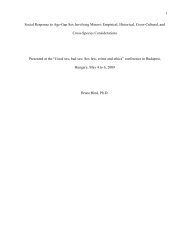PDF file - Ipce
PDF file - Ipce
PDF file - Ipce
You also want an ePaper? Increase the reach of your titles
YUMPU automatically turns print PDFs into web optimized ePapers that Google loves.
Book reviews<br />
Another problem is Jenkins at times does a disservice to the historical record, whose tapestry can<br />
be subtler than his discussion allows.<br />
For example, when discussing how the right used the threat of harm to children as an argument<br />
against homosexual rights, he observes that the North American Man/Boy Love Association<br />
(NAMBLA) was "deeply unpopular" with lesbian groups and that among mainstream gay<br />
organizations,<br />
"initial sympathy rapidly [gave] way to deep hostility. ... because acknowledging<br />
any commonality of goals was likely to attract the 'molester' label for all<br />
homosexuals defending hard-won political rights and public respectability" (p.<br />
162).<br />
He does not mention that in the early 1980s some lesbians and minor youth defended not only<br />
NAMBLA‘s participation in the political process but also the desirability of sexual relationships<br />
between minors and adults (Kelly, 1979; Anonymous, 1979/80; Lotringer & Moffett, 1980).<br />
Neither does he acknowledge that today many gay and lesbian activists reject respectability and<br />
some have called for a dialogue with those who advocate relationships between adults and<br />
underage males (Rofes, 1998).<br />
Occasional textual sloppiness compounds these flaws. On occasion he provides an account of<br />
statistical claimsmaking that does not make it clear who is doing the claiming and he cites Web<br />
documents without providing their addresses. He concludes demographic changes account for<br />
the shifts in how child sex abuse has been viewed, but does not mention Joel Best's argument<br />
against a demographic hypothesis (Best, 1990).<br />
Those doing research would best be served by using Moral Panic as a Baedeker for further<br />
exploration rather than relying on it as comprehensive or accurate. These criticisms<br />
notwithstanding, Jenkins provides an informative and valuable account of how the latest antichild<br />
sex laws have fixed the sexual deviance / paraphilia model more firmly in our society, to<br />
the detriment of children and adults.<br />
CONSTRUCTING THE CHILD MOLESTER<br />
Sonenschein focuses on three principal actors—pedophiles, children and adult protectors—in<br />
the symbolic crusade mentioned by Jenkins. His premise is we base social relations upon<br />
imagery, using symbols<br />
"animated and dubbed by their makers [which are] accompanied by standard,<br />
agreed upon and rigidly enforced texts that demand severe punishment for<br />
violation along with the elimination of criticism…." (v. II pp. 9-10).<br />
http://home.wanadoo.nl/ipce/newsletters/e_14/reviews.htm (4 of 9) [10/16/2002 5:34:25 PM]
















